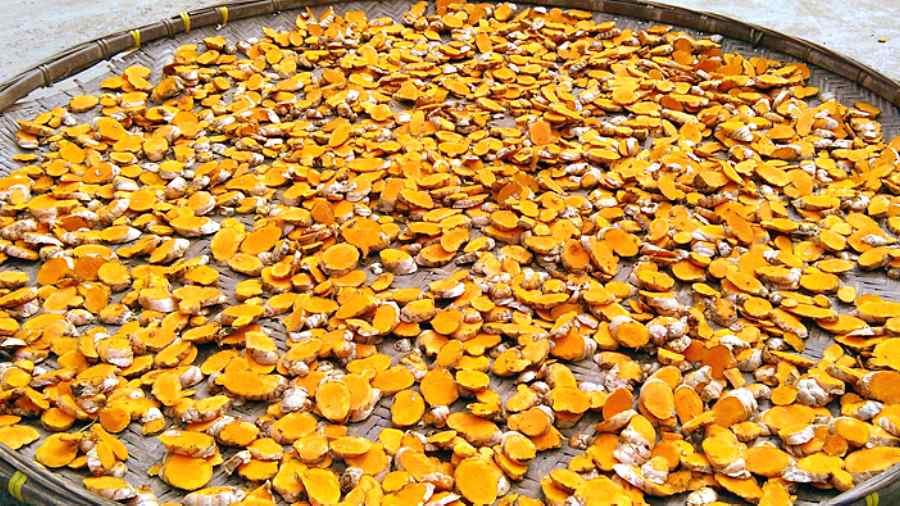This is the story of certain goldfields in Meghalaya, tracts along the Jaintia Hills that churn out the most brilliant kind of yellow. The people of the region always knew it was extra special and had been using it for centuries. But a few decades ago, they began to extract it commercially, albeit on a very small scale to begin with.
Things started changing at the turn of this century, and picked up pace enormously over the last few years. In April 2018, the state government launched Mission Lakadong, announcing a production target of 50,000 tonnes by 2023.
That is how Lakadong turmeric, a unique variety of the rhizome (underground stem) endemic to the region, started spreading its colour across the world.
“This turmeric has an intense reddish yellow hue. It grew in the wild and people knew about its medicinal value,” says K.N. Kumar, chairman of the Meghalaya Farmers (Empowerment) Commission. “Much later, they began to use it for culinary needs.”
Lakadong turmeric is so rich in appearance that other varieties pale in shade. The deeper the colour, the higher the curcumin content. Ordinary turmeric contains about 3 per cent curcumin, the Lakadong variety has 7.4 per cent.
Kumar explains, “Although we use the word curcumin generically, there are actually 17 types of curcuminoids. The Lakadong variety has a very high curcumin content, which includes all the curcuminoids. We even discovered specimens that have up to 10 per cent.”
Trinity Saioo was a schoolgirl in the 1980s when her parents grew this turmeric on a small scale. “Somehow they shifted to another variety, Lakashein turmeric, because it was easier to grow. They got a better crop by using fertilisers and pesticides, and the older one was forgotten,” she tells The Telegraph from Mulieh village, about 80 kilometres from Shillong.
The stories of Saioo and Lakadong turmeric are close-knit. In 2003, someone from the Spices Board of India visited her village, she recalls, offering a subsidy to grow this variety.
“They advised us not to use fertilisers and to grow the crop away from fields where fertilisers are used. I started following the method in my fields as well as in my sister’s fields… Most farmers don’t know how to read or write, so I helped them fill up the forms, open bank accounts, resolve their queries and so on. Many of them were afraid to make the change, they did not trust the officials. But when they saw me, they came forward. Between 2003 and 2015, I helped about 800 farmers,” says the affable 53-year-old.

Trinity Saioo (third from left) with other farmers. Photographs, courtesy Mission Lakadong
Saioo wears many hats. “I am a teacher — I have been teaching at the village school since I passed Class X — a farmer, a supplier of turmeric. I am also the head of the teachers’ body and was the secretary of my religious association — I am a Christian, a Catholic — until a few days ago when my term ended.”
And of course, she is also the mother of six children. She seems to be always on the move, evident from the fact that her phone is always buzzing. “I keep it on silent mode only when I am in school or in church,” she smiles.
But perhaps her biggest strength is her spirit of entrepreneurship. When the state launched Mission Lakadong, Saioo saw it as an opportunity.
“She volunteered to be part of a committee of 12 farmer leaders, all of them women,” says Kumar. “They advised the government on how to deepen the involvement of other farmers. We held meetings and every time we gathered insights, we made mid-course corrections. Whatever we needed to communicate, we did via them. They were our voice. And it worked.”
At the time of launching the project, there were about 1,000 farmers involved. Today, there are 10,000; all women.
“With Meghalaya largely being a matrilineal society, land ownership lies with the women. When we convene a meeting of farmers, there are hardly any men present. They probably spend more time in the processing part...,” says Kumar.
Of late, Lakadong turmeric has been receiving a lot of interest from buyers in the US, Japan, Netherlands and Germany. Says Kumar, “Recently, we received an order from Kerala for 100 metric tonnes. That actually means 800 metric tonnes of the fresh rhizome.”
Saioo explains the processing of it. “The main part is called the mother rhizome from which grow finger rhizomes. We don’t sell the mother rhizome, we keep it for the next year. Only the fingers are sliced, dried in the sun and sold.”
Saioo owns two grinding machines and has her own brand of turmeric.
“We never sell the fresh rhizomes; it’s a property of the nation,” Kumar adds.
In 2020, Saioo was awarded the Padma Shri for her efforts to sustain and popularise the farming of Lakadong turmeric, and also help increase the income of her community of women farmers. Mention the honour and she says, “It was part of God’s plan.”
As you sow, so shall you reap, in more ways than one.










